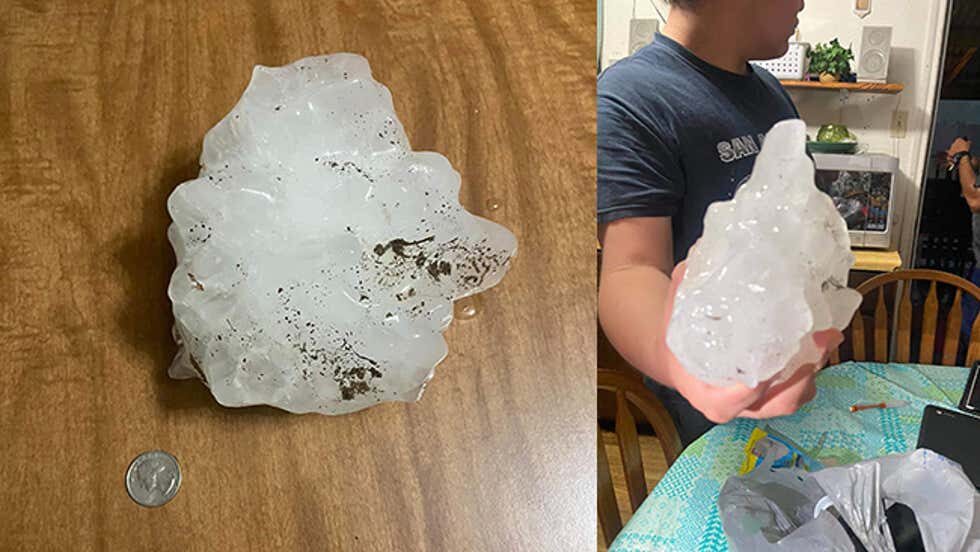
The hailstone was captured, photographed and shared on social media on April 28, in Hondo, Texas, about 40 miles west of downtown San Antonio. It was then put in a freezer.
Hail experts from the Insurance Institute for Business and Home Safety coordinated with the National Weather Service office in San Antonio to examine and perform a three-dimensional scan of the hailstone on May 6.
They found the mammoth hailstone was 6.4 inches in diameter, the largest stone the IBHS has scanned, or roughly the size of a honeydew melon.
The hailstone weighed about 1.26 pounds, according to the IBHS, a national nonprofit initiative of the insurance industry to reduce deaths, injury, property damage, economic losses and human suffering caused by natural disasters, including hailstorms.
You can see how the massive hailstone dwarfed the size of a quarter, which is the typical minimum size the National Weather Service considers to be severe hail, in the photos above.
On May 12, an ad hoc State Climate Extremes Committee (SCEC) of meteorologists and scientists convened to review the evidence and past historical records and determined the Hondo hailstone was a state record.
According to the SCEC report, the hailstone appeared larger in the photo taken just after it was collected April 28 than when it was measured May 6.
Unofficially, hail between 6 and 8 inches in diameter occurred on Dec. 6, 1892, in Gay Hill, Texas, according to weather historian Christopher Burt.
Another hailstorm on May 31, 1960, in Winkler County may have dumped hail up to 8 inches in diameter.
However, the SCEC report stated there was no direct photo evidence of either of those two events. Therefore, the Hondo hailstone became the official state record.
Strangely enough, this may not have been the largest hailstone in the storm.
The SCEC report mentioned another massive hailstone was collected near Hondo that evening. From the photo of this second hailstone, Matthew Kumjian of Penn State University estimated a hail diameter from 6.27 to 6.57 inches.
But this second hailstone was never measured and was "ultimately used for margaritas" by the person who took the photo, according to the SCEC.
The largest hailstone ever measured in the U.S. was 8 inches in diameter in Vivian, South Dakota, on July 23, 2010.
The Vivian hailstone was also the nation's heaviest (1.94 pounds). The world's heaviest hailstone was a 2.25-pound stone in Bangladesh in April 1986.
The massive hailstones may have been falling at speeds of 110 to 120 mph. It's no wonder these hailstones punctured through the roof, and even a ceiling, of at least one home.
The supercell responsible for the gargantuan hail tracked from northern Mexico into Del Rio, Texas, then into the city of Hondo before weakening, while still dumping hail up to golf ball-size on the west side of San Antonio.
An NWS damage survey found a 34-mile-long and up to 9-mile-wide swath of damaging winds in Medina County, including Hondo, from the supercell.
Winds estimated from 80 to 110 mph whipped the huge hailstones, leading to severe damage to vehicles, trees and roofs in a trailer park. A brief EF1 tornado was spawned southeast of Hondo, according to the NWS survey.
This South Texas storm was one of three separate hailstorms over Texas and Oklahoma on April 28, which likely inflicted at least $1 billion in damage combined.
Since 2009, state record hailstones have been documented in Colorado, Alabama, Illinois, Oklahoma and Vermont.
A 2020 study documented what might be a world record hailstone, possibly as wide as 9.3 inches, in Córdoba Province, Argentina, on Feb. 8, 2018.



Comment: Cosmic rays increases hail size and duration - Lightning inception by large ice particles, GSM much?